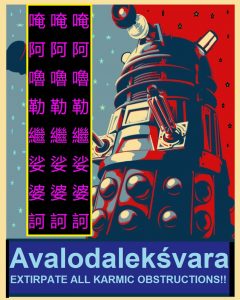予一生崇尚念佛
予 = yǔ = praise, esteem, give
一生 = yīshēng = all one’s life
崇尚 = chóngshàng = promote, praise
念佛 = niànfó = mindfulness of Buddha
Yúnqī Zhūhóng (雲棲袾宏; 1535–1615)
予 = yǔ = praise, esteem, give
一生 = yīshēng = all one’s life
崇尚 = chóngshàng = promote, praise
念佛 = niànfó = mindfulness of Buddha
Yúnqī Zhūhóng (雲棲袾宏; 1535–1615)

唵 阿嚕勒繼 娑婆訶
ǎn ālǔlēijì suōpóhē
옴 아로륵계 사바하
om a-ro-reuk-gye sabaha
おん あろりきゃ そわか
on arorikya sowaka
ओं आरोलिक् स्वाहा
oṃ ālolik svāhā
幽冥 教主
유명 교주
yumyeong gyoju
Guiding Teacher of the Dark Realms
幽冥 = dark/hidden + dark/gloomy = underword/hell
教主 = teach + emperor
大吉祥天女咒 Great Auspicious Goddess Mantra
南無佛陀 南無達摩 南無僧伽 南無室利 摩訶提鼻耶 怛你也他 波利富樓那 遮利三曼陀 達舍尼 摩訶毗訶羅伽帝 三曼陀 毗尼伽帝 摩訶迦利野 波禰 波囉 波禰 薩利嚩栗他 三曼陀 修鉢黎帝 富隸那 阿利那 達摩帝 摩訶毘鼓畢帝 摩訶彌勒帝 婁簸僧祗帝 醯帝簁 僧祗醯帝 三曼陀 阿他阿少免 婆羅尼
I love the way he smiles when he says, “Nothing is lost”, and the way he laughs when he says, “You become supernatural.” You can find a more detailed explanation also by Thich Nhat Hanh here: The Buddhist Understanding of Reality, but personally I think this video, in just slightly over 4 minutes, really is […]
29 components with 2 occurrences:
广 可 舟 皮 虫 𠂉 寺 灬 刀 皿 白 穴 廿 七 禾 刂 爫 耂 戌 曾 勹 𠫔 月 辶 扌 巾 兄 人 小
106 components with 1 occurrence:
林 手 右 必 巠 巛 雚 見 咅 产 生 亍 罙 㓁 昭 召 縕 𥁕 囚 比 亼 共 皀 卩 戠 复 夂 者 去 烕 火 后 爭 彐 亅 咸 攵 艮 畀 丌 千 殸 耳 声 未 角 蜀 介 ⺻ 歹 首 䒑 知 㝵 旦 戶 斤 是 垂 卄 士 衣 石 疑 龴 巩 凡 忄 布 袁 𧘇 离 㐫 禸 凵 乂 冂 眞 頁 到 至 九 圼 般 弗 弓 豸 兒 臼 礻 申 𥫗 ⺼ 余 貫 毌 貝 虍 业 ⺊ 兌 曷 曰 匃 帝 少
This is based on the 260 character version attributed to Xuanzang. But note that when you include the title, there are actually 270 total characters. Obviously you get different results if you exclude the title, or if you use a shorter version of the title. Many people, including myself, recite the title twice (once at […]
So we can see from all of this that the teachings can freely use
seemingly different expedient means and expressions to point to the
same universal substance. Only the words themselves have a
different appearance and meaning, yet the point they communicate
is the same. For one whose insight is in accord with his actions, it is
possible to see through what is said to be “near” or “far.” This is why
our tradition can embrace both ways of practice: calling out to Amita
Buddha, like Hui-yuan, and looking directly into true nature, like
Jui-yen.
修行 = xiūxíng = “practice” = to cultivate one’s spiritual virtues; to train oneself; to work at self-improvement (wiktionary); to devote oneself to spiritual development (esp. Buddhism or Daoism); to devote oneself to perfecting one’s art or craft (purple culture)
Buddhists throughout East Asia chant the version of the Heart Sutra that goes back to the legendary translator Xuanzang, who lived about 14 hundred years ago. That is to say, Buddhists in China, Vietnam, Japan, and Korea all use Xuanzang’s text, but they pronounce the 270 characters in that text differently. Below you can find […]